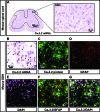Antigen retrieval pre-treatment causes a different expression pattern of Cav3.2 in rat and mouse spinal dorsal horn
- PMID: 30678436
- PMCID: PMC6346256
- DOI: 10.4081/ejh.2019.2988
Antigen retrieval pre-treatment causes a different expression pattern of Cav3.2 in rat and mouse spinal dorsal horn
Abstract
Cav3 channels consist of three isoforms, Cav3.1 (α1G), Cav3.2 (α1H), and Cav3.3 (α1I), which produce low-threshold spikes that trigger burst firings in nociceptive neurons of the spinal dorsal horn (SDH) and dorsal root ganglion (DRG). Although Cav3.2 plays a crucial role in pathological pain, its distribution in SDH still remains controversial. One study showed that Cav3.2 is ubiquitously expressed in neurons, but another study implied that Cav3.2 is expressed restricted to astrocytes. To unravel these discrepancies, we used methods of immunohistochemistry either with or without antigen retrieval (AR) pre-treatment to detect Cav3 in SDH and DRG from both rats and mice. Moreover, Cav3.2 mRNA was detected in mice SDH using in situ hybridization. We found that the expression pattern of Cav3.2 but not Cav3.1 and Cav3.3 in SDH were largely different with or without AR pre-treatment, which showed a neuron-like and an astrocyte-like appearance, respectively. Double staining further demonstrated that Cav3.2 was mainly co-stained with the neuronal marker NeuN in the presence of AR but was with glial fibrillary acidic protein (GFAP, marker for astrocytes) in the absence of AR pre-treatment. Importantly, Cav3.2 mRNA was mainly co-localized with Cav3.2 but not GFAP. Together, our findings indicate that AR pre-treatment or not impacts the expression pattern of Cav3.2, which may make a significant contribution to the future study of Cav3.2 in SDH.
Conflict of interest statement
Conflict of interest: The authors declare no conflict of interest.
Figures





Similar articles
-
Immunohistological demonstration of CaV3.2 T-type voltage-gated calcium channel expression in soma of dorsal root ganglion neurons and peripheral axons of rat and mouse.Neuroscience. 2013 Oct 10;250:263-74. doi: 10.1016/j.neuroscience.2013.07.005. Epub 2013 Jul 15. Neuroscience. 2013. PMID: 23867767 Free PMC article.
-
Nerve injury elevates functional Cav3.2 channels in superficial spinal dorsal horn.Mol Pain. 2019 Jan-Dec;15:1744806919836569. doi: 10.1177/1744806919836569. Mol Pain. 2019. PMID: 30803310 Free PMC article.
-
Upregulation of Cav3.2 T-type calcium channels in adjacent intact L4 dorsal root ganglion neurons in neuropathic pain rats with L5 spinal nerve ligation.Neurosci Res. 2019 May;142:30-37. doi: 10.1016/j.neures.2018.04.002. Epub 2018 Apr 21. Neurosci Res. 2019. PMID: 29684385
-
Targeting T-type/CaV3.2 channels for chronic pain.Transl Res. 2021 Aug;234:20-30. doi: 10.1016/j.trsl.2021.01.002. Epub 2021 Jan 7. Transl Res. 2021. PMID: 33422652 Free PMC article. Review.
-
H2S and Pain: A Novel Aspect for Processing of Somatic, Visceral and Neuropathic Pain Signals.Handb Exp Pharmacol. 2015;230:217-30. doi: 10.1007/978-3-319-18144-8_11. Handb Exp Pharmacol. 2015. PMID: 26162837 Review.
Cited by
-
Twenty years of histochemistry in the third millennium, browsing the scientific literature.Eur J Histochem. 2020 Dec 29;64(4):3213. doi: 10.4081/ejh.2020.3213. Eur J Histochem. 2020. PMID: 33478199 Free PMC article.
-
Maturational Stage-Dependent Contributions of the Cav3.2 T-Type Calcium Channel to Dentate Gyrus Granule Cell Excitability.eNeuro. 2025 Apr 4;12(4):ENEURO.0423-24.2025. doi: 10.1523/ENEURO.0423-24.2025. Print 2025 Apr. eNeuro. 2025. PMID: 40068874 Free PMC article.
-
Multiple Calcium Channel Types with Unique Expression Patterns Mediate Retinal Signaling at Bipolar Cell Ribbon Synapses.J Neurosci. 2022 Aug 24;42(34):6487-6505. doi: 10.1523/JNEUROSCI.0183-22.2022. Epub 2022 Jul 27. J Neurosci. 2022. PMID: 35896423 Free PMC article.
-
Electrophysiological and Morphological Features of Rebound Depolarization Characterized Interneurons in Rat Superficial Spinal Dorsal Horn.Front Cell Neurosci. 2021 Sep 21;15:736879. doi: 10.3389/fncel.2021.736879. eCollection 2021. Front Cell Neurosci. 2021. PMID: 34621158 Free PMC article.
References
-
- Perez-Reyes E. Molecular physiology of low-voltage-activated t-type calcium channels. Physiol Rev 2003;83:117-61. - PubMed
-
- Mckay BE, Mcrory JE, Molineux ML, Hamid J, Snutch TP, Zamponi GW, et al. CaV3 T-type calcium channel isoforms differentially distribute to somatic and dendritic compartments in rat central neurons. Eur J Neurosci 2006; 24:2581-94. - PubMed
-
- Chen YL, Tsaur ML, Wang SW, Wang TY, Hung YC, Lin CS, et al. Chronic intrathecal infusion of mibefradil, ethosuximide and nickel attenuates nerve ligation-induced pain in rats. Br J Anaesth 2015;115:105-11. - PubMed
MeSH terms
Substances
LinkOut - more resources
Full Text Sources
Research Materials
Miscellaneous

